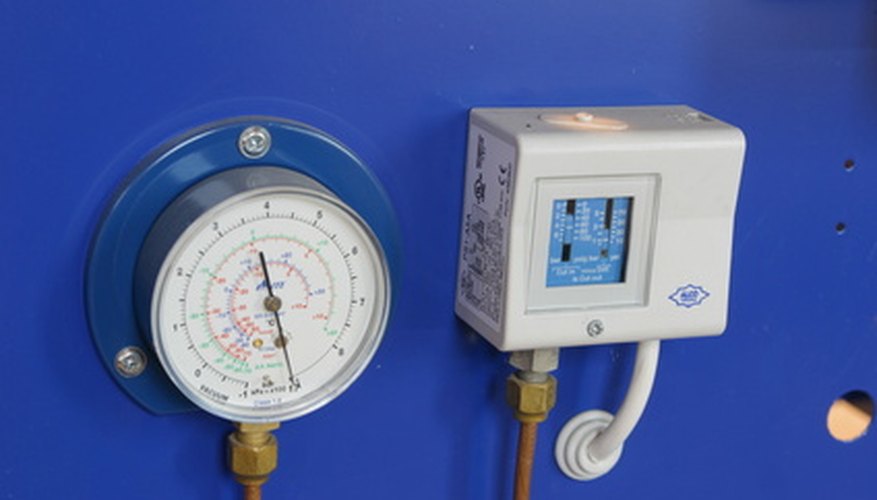Air conditioning and refrigeration systems provide cooling (and heating) by circulating a refrigerant through a system containing a compressor, condenser, thermal expansion valve and an evaporator. The refrigerant gas is compressed, cooled and expanded to reduce its temperature and pressure, and evaporated to remove heat from living spaces or refrigeration systems. Measuring superheat and subcooling can help you troubleshoot your refrigeration system. Improper subcooling or superheat can indicate a variety of problems requiring you to clean or service your system.
Start the refrigeration system and run it for at least 10 minutes to establish steady-state temperatures. Connect the refrigerant manifold gauges to the suction service valve between the evaporator and the compressor. Connect the pipe clamp thermocouple to the suction line near the suction service valve. Connect the thermocouple to a digital thermometer.
- Air conditioning and refrigeration systems provide cooling (and heating) by circulating a refrigerant through a system containing a compressor, condenser, thermal expansion valve and an evaporator.
- Connect the pipe clamp thermocouple to the suction line near the suction service valve.
Measure the suction line pressure using the refrigerant pressure gauge. Record this pressure and the suction line temperature from the thermometer. Use the refrigerant temperature/pressure chart to convert the pressure gauge reading to evaporator saturation temperature.
- Measure the suction line pressure using the refrigerant pressure gauge.
- Use the refrigerant temperature/pressure chart to convert the pressure gauge reading to evaporator saturation temperature.
Subtract the evaporator saturation temperature from the thermocouple temperature. This difference is the system superheat. This shows the temperature rise above the bubble point temperature of the system. Review the operating specifications for your system to determine the proper superheat. Inadequate superheat can cause liquid refrigerant to return to the compressor, resulting in compressor damage. Incorrect superheat can also indicate improper refrigerant charge, thermal expansion device problems, a clogged filter-drier or a dirty condenser coil.
Run the refrigeration system to establish steady-state temperatures. Connect the refrigerant manifold gauges to the discharge service valve, and the pipe clamp thermocouple to the refrigerant line between the discharge of the condenser and the thermal expansion valve.
Measure the condenser pressure at the service valve by reading the pressure on the refrigerant manifold gauges. Read the thermocouple temperature on the digital thermometer. Use the refrigerant pressure/temperature chart to convert the pressure reading to the condenser saturation temperature.
- Run the refrigeration system to establish steady-state temperatures.
- Use the refrigerant pressure/temperature chart to convert the pressure reading to the condenser saturation temperature.
Subtract the condenser saturation temperature from the thermocouple temperature. This is the amount of subcooling. Inadequate subcooling can result from a variety of problems, including inadequate airflow over the condenser, insufficient refrigerant charge, or problems with the thermal expansion valve.
TIP
Optimum superheat and subcooling temperatures vary for different systems. Contact the refrigeration or air conditioning manufacturer for their recommended values for systems properly charged with refrigerant. Newer refrigerants that are blends of two or more gases may have a difference in the dew and bubble point temperatures, commonly called "glide". Use the dew point temperature on the pressure/temperature chart to obtain the evaporator saturation temperature for superheat, and the bubble point temperature to obtain the condenser saturation temperature to measure subcooling. Wrap your thermocouples with insulation to obtain accurate pipe temperatures.
WARNING
Wear gloves and eye protection when working with pressurised refrigerants. Refrigerants can cause freezing if they spray on your skin. If you need to recharge a system due to low refrigerant charge, it is illegal to vent the old refrigerant into the air. Recycle the refrigerant gas using recycling equipment or contact a refrigeration professional for assistance. Obtain professional assistance if you do not understand the causes of the superheat/subcooling values you obtain. Do not randomly chase solutions; you can cause more damage to your system.
